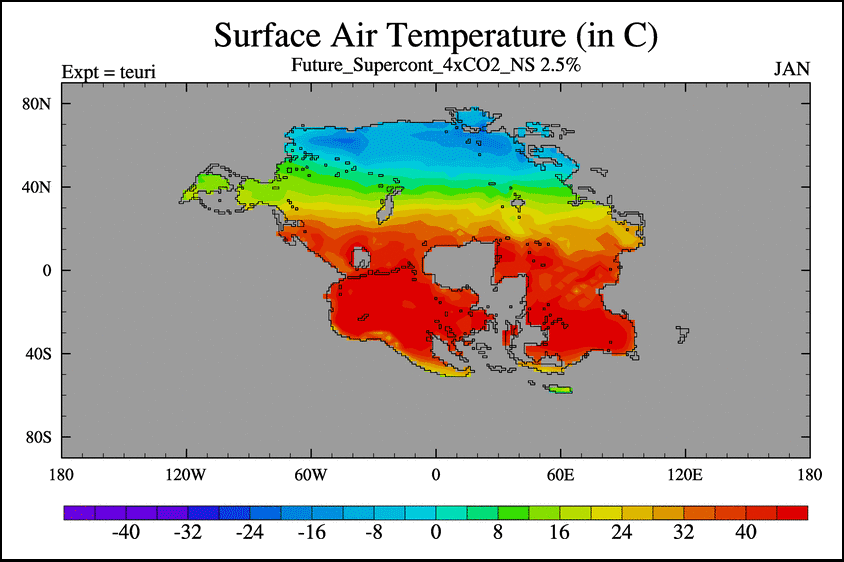It sounds like something from an apocalyptic sci-fi movie: Continents collide and trigger volcanic turmoil. Toxic gases fill the air. The planet becomes a hot desert devoid of life. But that scenario could very well predict Earth several million years in the future as the continents regroup into one, Pangea Ultima.
A new study published in Nature Geoscience projects that as this new supercontinent forms in around 250 million years, a hotter Sun, an absence of ocean coastline, and increased volcanic carbon dioxide (CO2) emissions mean that temperatures, particularly in landlocked areas, will skyrocket. The study suggests that this distant future foretells a mass extinction for mammals.
“When you see a supercontinent forming, it predisposes the environment or the climate to become more fragile for species, more towards these tipping points that can push big extinction events to occur.”
Alexander Farnsworth, a paleoclimatologist at the University of Bristol and one of the authors of the study, usually studies climates of the past (though he has also built models to assess the accuracy of the climate in fictional worlds, like Game of Thrones’ Westeros). During the pandemic, he began wondering if it was possible to predict climate conditions hundreds of millions of years from now on a supercontinent.
“When you see a supercontinent forming, it predisposes the environment or the climate to become more fragile for species, more towards these tipping points that can push big extinction events to occur,” he said.
It’s Back…
The original Pangea, the most recent supercontinent configuration, was broken apart by plate tectonics—geological forces moving the continents’ underlying puzzle pieces.
“Because Earth’s tectonic plates are moving on a sphere and always moving towards other plates, they tend to collide together every 500 million years or so,” said Benjamin Mills, a biogeochemist from the University of Leeds and one of the study authors. Pangea broke apart around 200 million years ago, and the continents are due to reconnect in another 200–300 million years, he said.
Computer modeling efforts such as PALEOMAP can predict how the continents might converge, and Pangea Ultima is one widely accepted possibility. To form Pangea Ultima, Africa would rotate into the coast of North America, and Eurasia would rotate clockwise and converge.
“Today, we have the Ring of Fire in the Pacific; we’ll have a ring of fire around what is now the Atlantic as it starts closing,” says Marcia Bjornerud, a structural geologist at Lawrence University who was not involved in the study.
An Unlivable Planet
One thing is certain from the study’s models: Pangea Ultima is going to be very, very unpleasant for mammals. Most of the landmass will be far from an ocean, and the arid expanses in the supercontinent’s interior will be between 50°C and 65°C during an average summer—too hot even for most plants to grow. Although pockets of slightly more habitable terrain may exist near the poles, competition between any other surviving species will be fierce. The coasts won’t be much better, with ocean evaporation causing extreme humidity.

“When it’s too humid, it’s too difficult for humans to sweat,” Farnsworth said. “If we can’t sweat, we can’t remove that internal body heat, and we keep getting hotter and hotter, cooking our own organs, essentially.”
Below the surface, the subduction of oceanic crust beneath continental crust can lead to the formation of continental volcanic arcs, or chains of CO2-spewing volcanoes that can be thousands of kilometers long. “Not only do they lead to CO2 release,” Mills said, “but when magma ascends through the continental crust, it can heat carbon-rich rocks, which can release a lot of additional carbon dioxide.”
In addition to the terrestrial concerns, the researchers noted that in 250 million years, the Sun will emit 2.5% more energy because of an increase in fusion reactions—further contributing to a climate that’s impossible for mammals to tolerate.
The researchers’ next steps are to do similar modeling on future oceans to investigate how intense warming and increasing oxygen might affect marine species survival. Farnsworth said they also plan to look at supercontinent formation and climate on shorter timescales of 2- to 5-million-year increments to measure how continent movement and heat begin to ramp up.
Two Hundred Fifty Million Years Is a Long Way Off
Although Pangea Ultima sounds bleak, the timescales of such tectonic upheavals mean the future presented in this study is not exactly imminent.
“If we look back 250 million years ago, the Earth was very different. There was another supercontinent. The biosphere was totally different,” Bjornerud said. “The Rockies didn’t exist 200 million years ago. The Alps didn’t exist. The Himalayas didn’t exist. Some of the things we think of as fixed in geography didn’t yet exist.”
“It’s interesting to think about future Earth, but we need to be stewards of now.”
But even though a future Earth may be too hot to sustain life as we know it, this research helps us consider our own place in Earth’s present: Humans exist in a tectonic and climate sweet spot that’s allowed life to proliferate. We also have the tools and technology to slow anthropogenic climate change and make a difference in our current era.
“The article reminds us how this current moment of human time requires the constellation of a lot of different geologic factors. Sure, it’s fascinating to look this far in the future,” Bjornerud said. “But none of this is relevant if we cause mass extinctions in the next century and a half. It’s interesting to think about future Earth, but we need to be stewards of now.”
—Rebecca Owen (@beccapox), Science Writer
This news article is included in our ENGAGE resource for educators seeking science news for their classroom lessons. Browse all ENGAGE articles, and share with your fellow educators how you integrated the article into an activity in the comments section below.


